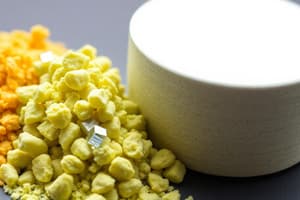Podcast
Questions and Answers
What does composition mean in the context of materials science?
What does composition mean in the context of materials science?
The chemical make-up of a material.
What does structure refer to in materials science?
What does structure refer to in materials science?
A description of the arrangements of atoms or ions in a material.
Define synthesis in materials science.
Define synthesis in materials science.
The process by which materials are made from naturally occurring or other chemicals.
What is processing in the context of materials science?
What is processing in the context of materials science?
Which of the following are categories of materials? (Select all that apply)
Which of the following are categories of materials? (Select all that apply)
The unique behavior of __________ is important for transistors and integrated circuits.
The unique behavior of __________ is important for transistors and integrated circuits.
What are thermoplastics characterized by?
What are thermoplastics characterized by?
Match the following materials with their applications:
Match the following materials with their applications:
What is the main use of tungsten carbide-cobalt composites?
What is the main use of tungsten carbide-cobalt composites?
What distinguishes thermosetting polymers from thermoplastics?
What distinguishes thermosetting polymers from thermoplastics?
Which functional classification does carbon-fiber-reinforced polymer belong to?
Which functional classification does carbon-fiber-reinforced polymer belong to?
What is a primary characteristic of semiconductor materials used in electronics?
What is a primary characteristic of semiconductor materials used in electronics?
Which of the following materials is least likely to be categorized as a smart material?
Which of the following materials is least likely to be categorized as a smart material?
What role do polymers play in electronic devices like computer dip switches?
What role do polymers play in electronic devices like computer dip switches?
What is the most significant aspect of the performance of a technology or material in the context of material science and engineering?
What is the most significant aspect of the performance of a technology or material in the context of material science and engineering?
In the context of movie technology, synthesis relates most directly to which aspect of material science?
In the context of movie technology, synthesis relates most directly to which aspect of material science?
Which of the following factors is LEAST relevant when discussing the processing and synthesis of materials featured in movies?
Which of the following factors is LEAST relevant when discussing the processing and synthesis of materials featured in movies?
When selecting a material from a science fiction movie for analysis, which element of material science is essential to consider?
When selecting a material from a science fiction movie for analysis, which element of material science is essential to consider?
Estimating the cost of a technology or material in the context of material science often involves which of the following considerations?
Estimating the cost of a technology or material in the context of material science often involves which of the following considerations?
Flashcards are hidden until you start studying
Study Notes
What is Materials Science and Engineering?
- Materials Science and Engineering is concerned with the relationships between the composition, structure, process, properties, and performance of materials.
- Understanding the tetrahedron of materials science helps us to understand how properties are affected by the other factors - composition, structure, process and performance are all interlinked.
Classification of Materials
- Metals and Alloys are strong, ductile and good conductors of heat and electricity.
- Ceramics, Glasses and Glass-ceramics are hard, brittle, good insulators with high melting temperatures.
- Polymers (plastics) are lightweight, flexible, and often good insulators.
- Semiconductors have electrical conductivity between conductors and insulators.
- Composite Materials combine the properties of two or more materials, such as high strength and low weight.
Functional Classification of Materials
- Different materials will be used for specific purposes, due to their unique properties.
Classification of Materials Based on Structure
- The arrangement of atoms / ions is key to understanding the behavior of materials.
- Metals are characterized by a regular arrangement of atoms in a crystal lattice.
- Ceramics are often inorganic compounds with a more complex structure.
- Polymers consist of long chain molecules.
Environmental and Other Effects
- Temperature can significantly affect the mechanical properties of materials.
- Corrosion can occur in metals due to chemical reactions with their environment.
- Radiation can alter the properties of materials.
Materials Design and Selection
- The choice of material is crucial for any application.
- Performance-to-cost ratio is a key factor in material selection.
- Different material categories have strengths and weaknesses, requiring careful consideration for design.
Polymerization
- Small molecules combine to produce larger molecules, or polymers.
- Polymers can have a structure that consists of many chains that are entangled but not connected (thermoplastics).
- Polymers can also form three-dimensional networks in which chains are cross-linked (thermosets).
Materials Science and Applications
- Polymers are used in various electronic devices.
- Integrated circuits rely on the electrical behavior of semiconducting materials.
- Advanced helicopters rely on a material composed of a carbon-fiber-reinforced polymer.
Functional Classification of Materials
- Materials are classified according to their function.
- Aerospace, biomedical, electronic, energy, magnetic, photonic, smart, and structural materials are included in this classification.
Grain Size and Yield Strength
- The atoms near the boundaries of the three grains do not have an equilibrium spacing or arrangement.
- Grains and grain boundaries are present in a stainless steel sample.
- The grain size can affect the yield strength of steel at room temperature.
Microstructure of Materials
- The microstructure of palladium reveals its physical organization.
- Small angle grain boundaries are formed by an array of dislocations, causing an angular mismatch between lattices on either side of the boundary.
- Twins can form in crystals due to stress, causing a displacement of atoms.
- Micrographs of twins in brass show their formation.
Diffusion in Materials
- Diffusion is the movement of atoms or molecules from one region to another.
- The diffusion coefficient, D, is a measure of the rate of diffusion.
- The Arrhenius plot shows how the diffusion coefficient varies with temperature.
- Diffusion coefficients vary for different dopants in silicon.
- Diffusion in ionic compounds is a key process.
- Diffusion coefficients vary for ions in different oxides.
Permeability in Polymers
- Permeability is the rate at which gas or vapor can pass through a material.
- The permeability of polymers is influenced by factors such as temperature and humidity.
Design of Carbonated Beverage Bottles
- Selecting a polymer for carbonated beverage bottles requires consideration of several factors.
- Small diffusivity for carbon dioxide is crucial to prevent the beverage from going flat.
- Strength and durability are essential for the bottle to withstand drops.
- Printing labels on the bottle surface is necessary for product identification.
- Polymer processing techniques can affect the microstructure of the bottle.
Composition Profile and Diffusion
- Fick's second law describes the rate of redistribution of atoms by diffusion.
- Interdiffusion occurs when different atoms diffuse in opposite directions.
- The Kirkendall effect is the physical movement of an interface due to unequal diffusion rates.
- "Purple plague" is the formation of voids in gold-aluminum welds due to unequal diffusion rates, which can lead to weld failure.
Studying That Suits You
Use AI to generate personalized quizzes and flashcards to suit your learning preferences.




